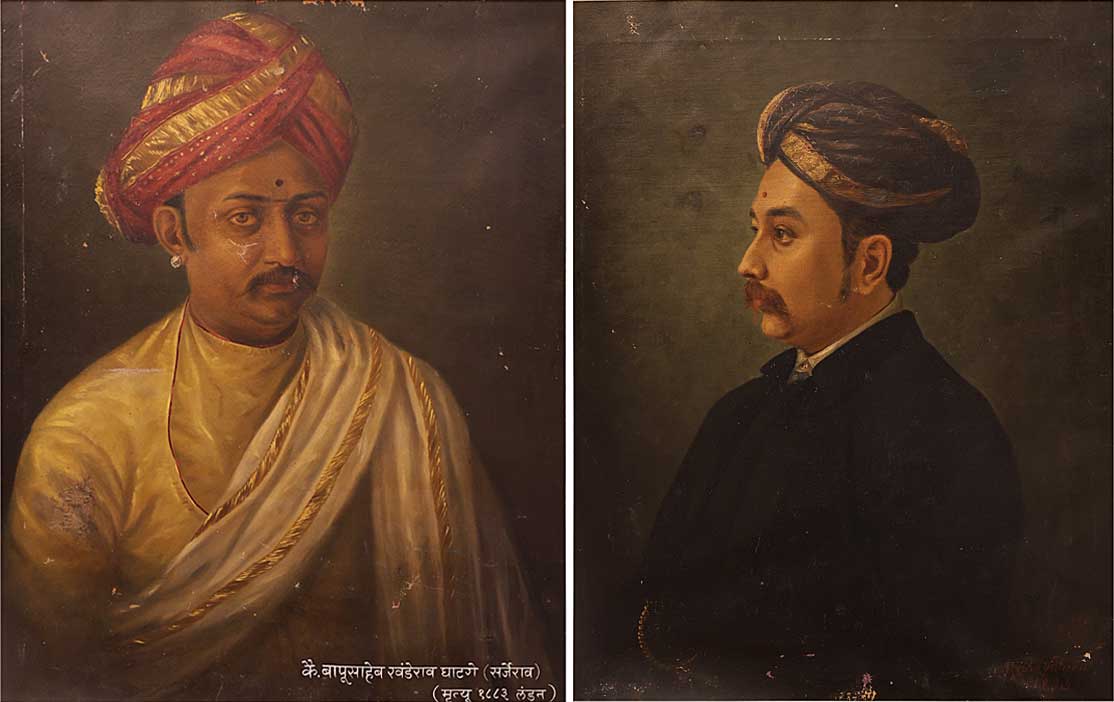
Shrimant Ramsaheb Khanderao Ghatge &
Shrimant Bapusaheb Khanderao Ghatge
These portraits depict Shrimant Ramsaheb Khanderao Ghatge (d. 1896) and his elder brother Shrimant Bapusaheb Khanderao Ghatge (Left), both relatives of Shrimant Maharaja Sayajirao Gaekwad (III) of Baroda. Owing to political tensions and affiliations with anti-British factions, the Ghatge brothers were exiled from Baroda and forced to settle in Sangli, Maharashtra. Their lives were spared due to the intervention of Diwan Sir T. Madhava Rao, who continued to guide them during their exile. It was likely through him that Raja Ravi Varma was introduced to the Ghatges. During the late 1880s, prior to gaining full patronage at the Baroda court. These works are one of his early commissions (one painting is signed and dated 1893), illustrating his growing reputation among regional nobility and the pivotal role of the Diwan in shaping those connections.
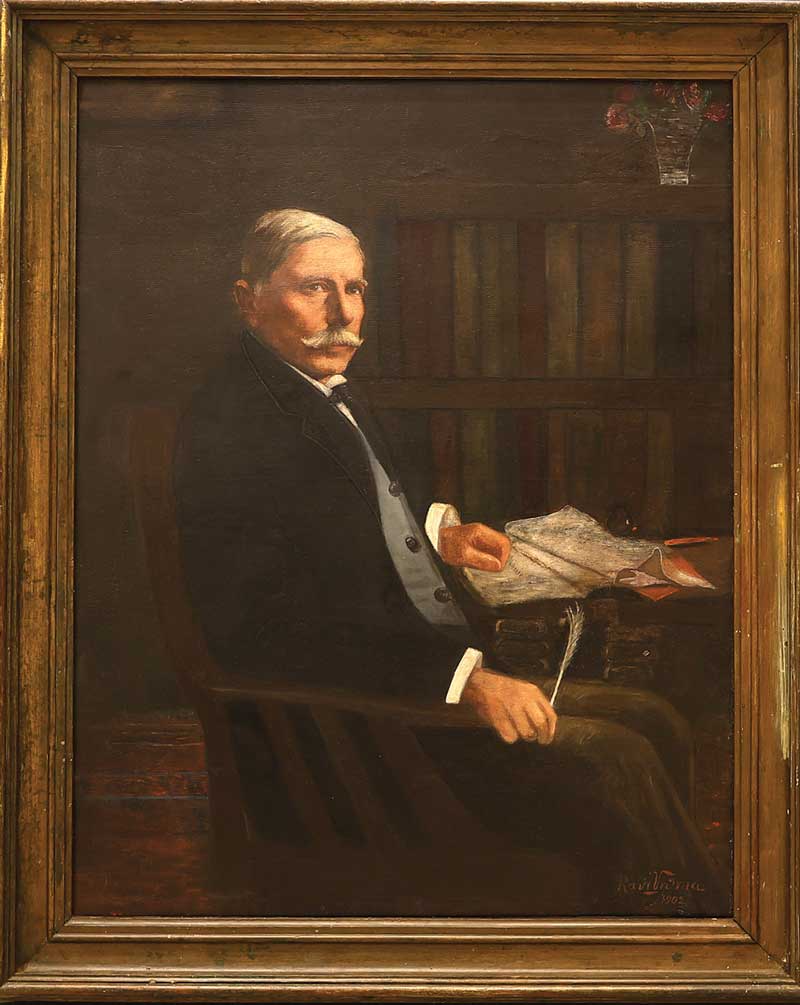
Portrait of John Duncan Inverarity
This painting, dated 1902, is a signed original oil on canvas by Raja Ravi Varma and is now identified as a portrait of John Duncan Inverarity, a prominent barrister of the Bombay High Court. Through extensive research—including a comparison with a 1923 Scottish newspaper photograph, a commemorative tablet at the Bombay High Court, and a painting in its library—the sitter for this painting has been clearly identified as JD Inverarity. Further confirmation is found in the book A Heritage of Judging: The Bombay High Court Through One Hundred and Fifty Years (1862–2012), published by the Maharashtra Judicial Academy and Indian Mediation Centre & Training Institute. This portrait reflects Varma’s engagement with colonial legal elites during the early 20th century.
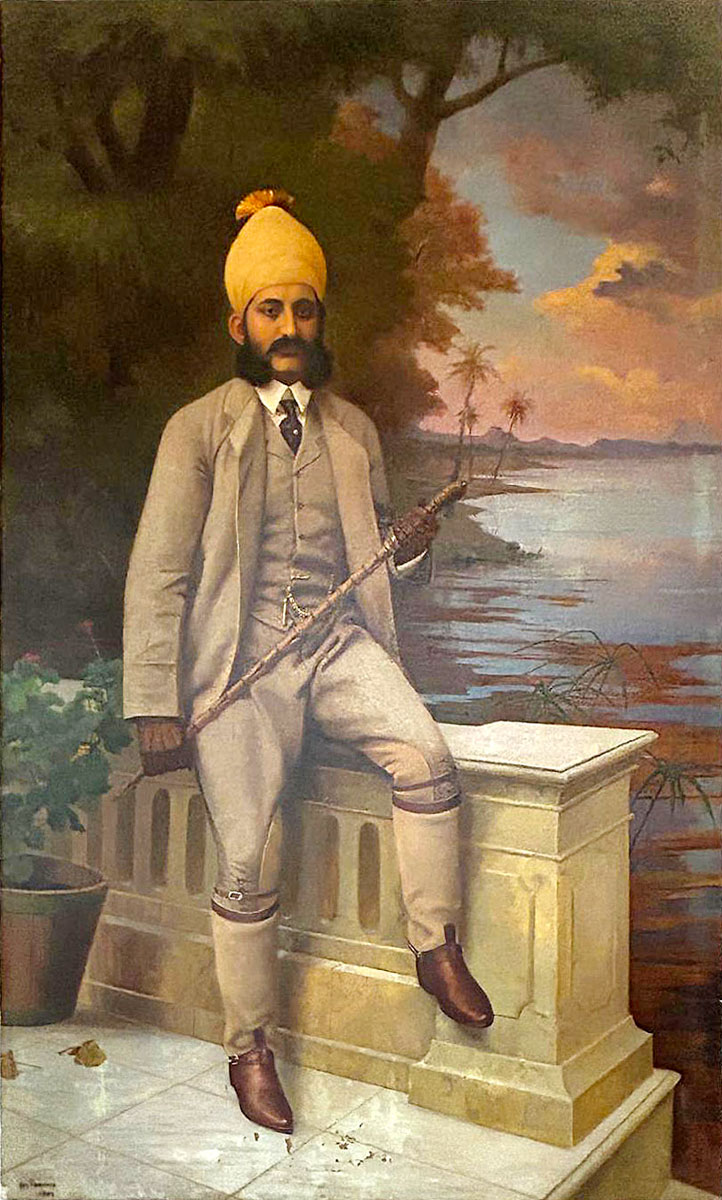
H.E.H. Mir Mahbub Ali Khan Asaf Jah VI
This portrait depicts H.E.H. Mir Mahbub Ali Khan Asaf Jah VI, the sixth Nizam of Hyderabad (r. 1869–1911), one of the wealthiest and most powerful princely rulers of his time. Raja Ravi Varma was commissioned to paint the Nizam during a period when the artist had gained considerable recognition across royal courts in India. The portrait is notable for its regal composition and meticulous detailing, capturing the Nizam’s authority and sophistication, adorned in ceremonial regalia. Though the exact date of the painting is not recorded, it is believed to have been executed in the late 1890s or early 1900s, aligning with Varma’s peak years of royal patronage. It is one of the few surviving portraits of the Nizam rendered by an Indian artist and stands as a testament to Varma’s stature among both Indian and colonial elites.
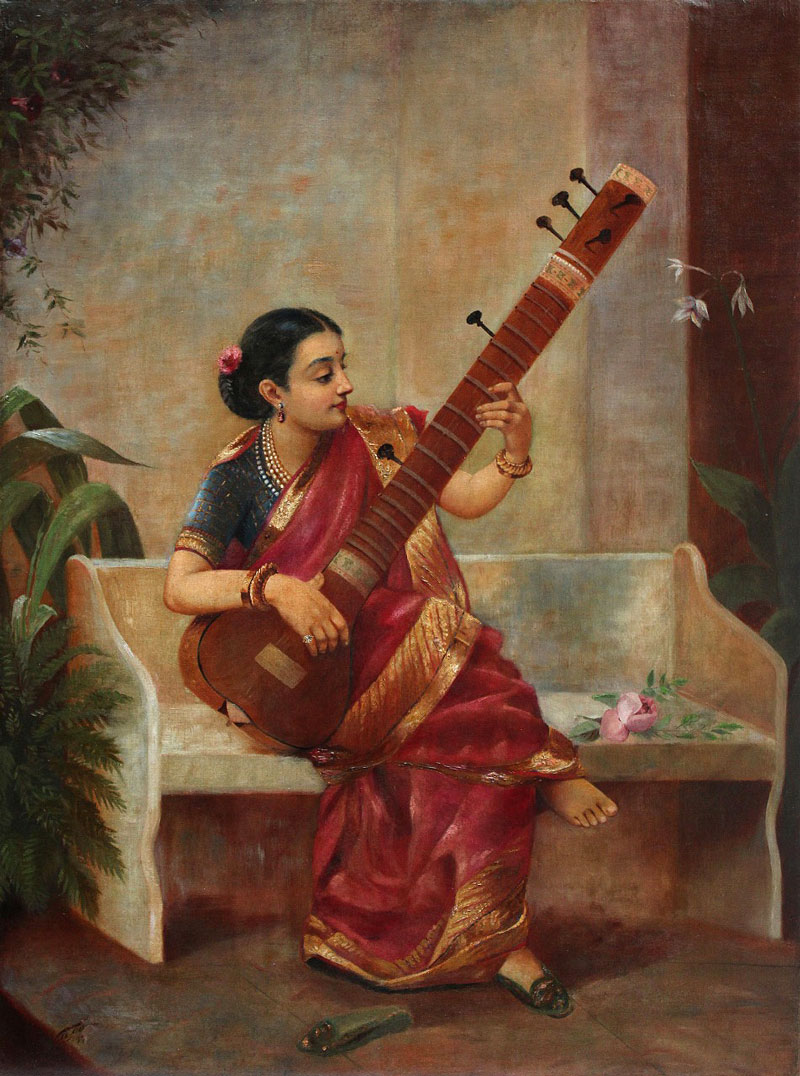
Music Hath Charms
Raja Ravi Varma depicted many women playing musical instruments; this is a theme that was created several times over as the artist was very familiar with women who were trained classically as musicians.
He painted several ‘Nair’ women playing instruments, and also singers and classical musicians who were similarly trained in these art forms. The theme of women playing a musical instrument was one perennial to the culture that Ravi Varma grew up in. Hence this theme recurred in several of the artist’s finest works.
This painting has been titled ‘Music Hath Charms’ (written on reverse) and the size of the work clearly indicates that this was made by the hand of the artist as an exemplar for production of an oleograph/lithographic print.
This painting, which is signed (on the left corner), bears accurate description and style of art works of Raja Ravi Varma in consideration of subject, colour pallet, soft handling of colours and treatment of humanistic emotions and portrayal of the same, and is hereby certified as an ‘Signed Original by the Hand of the Artist’.

Portrait of Dr. Bhalachandra Krishna Bhatwadekar
Painted in 1892 and signed ‘Ravi Varma’, this portrait is of Dr. Bhalachandra Krishna Bhatwadekar, one of the most important patrons and friends of the Varma brothers. They brothers visited and stayed with Dr Bhalachandra on several occasions at his home in Girgaum, Bombay. They borrowed money from the doctor to start the Ravi Varma Press and were also regularly treated by him for common illnesses. Dr. Bhalachandra is believed to be one of the few people present at Ravi Varma’s bedside in Kilimanoor at the time of his demise in 1906.
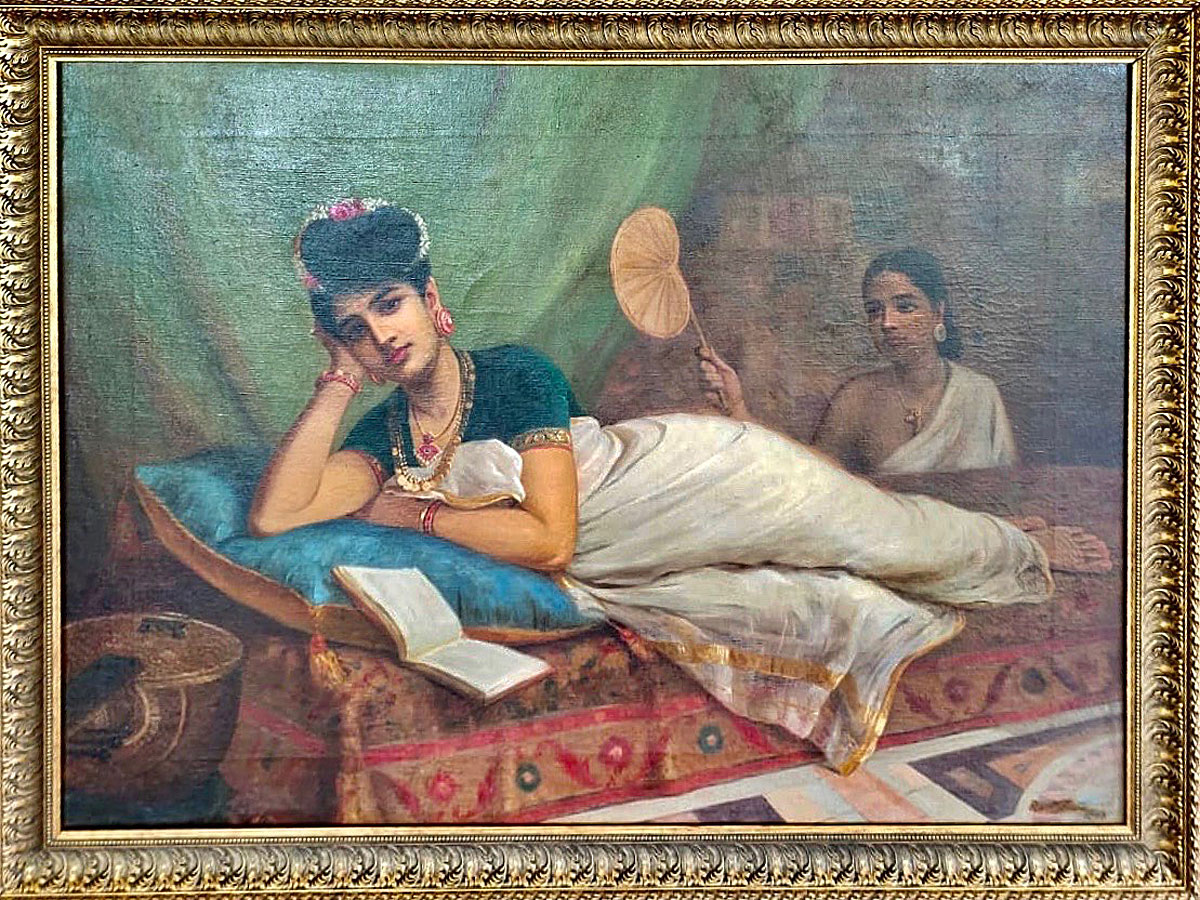
Reclining Nair Lady
Painted in 1902, this signed work by Raja Ravi Varma is reminiscent of Eduardo Manet’s ‘Olympia’. Yet the stylistic and cultural adaption of the work could have been achieved by none other than this master artist. Ravi Varma had a large collection of foreign art books purchased at various shops in Bombay and Madras and he used to spend considerable time studying them. He was well aware of Impressionism, a movement that revolted against academic conventions in France during the 1860s and of Manet, one of the most important practitioners of this movement. While Reclining Nair Lady is the result of a direct reference to Manet’s work, it is apparent that he was equally cognizant with the imagery of several European painters in India who made canvases of foreign ‘nabobs’, their native entourage and their exotic ‘bibis’.
This painting, which is signed, bears accurate description and style of art works of Raja Ravi Varma in consideration of subject, colour pallet, soft handling of colours and treatment of humanistic emotions and portrayal of the same, and is hereby certified as a ‘Signed Original’.
.jpg)
Untitled (Shiva)
This painting by Raja Ravi Varma (29.5" X 21.5", Oil on Canvas, Signed and Dated 1903) was brought to the Raja Ravi Varma Heritage Foundation in 2017 heavily overpainted and in need of restoration. The lead authenticators for the artwork were Dr. Choodamani Nandagopal and Mrs. Rupika Chawla. The artwork was meticulously restored and then handed over to its new owner. As a result, this precious jewel of art was both rescued and housed again.
This is a painting of Lord Shiva depicted as Dakhshinamurthy, as a teacher of yoga, music, and wisdom, offering an exposition of the Shastras. In his aspect as Jnana Dakshinamurti, Shiva is generally shown with four arms. He is depicted seated under a banyan tree, facing the south. The details captured by Ravi Varma in this painting are accurate and explicit.
It is important to note that the Foundation does not charge for its advisory services, opinions, or authentications. Furthermore, none of its activities related to preservation and restoration have any commercial bearing.
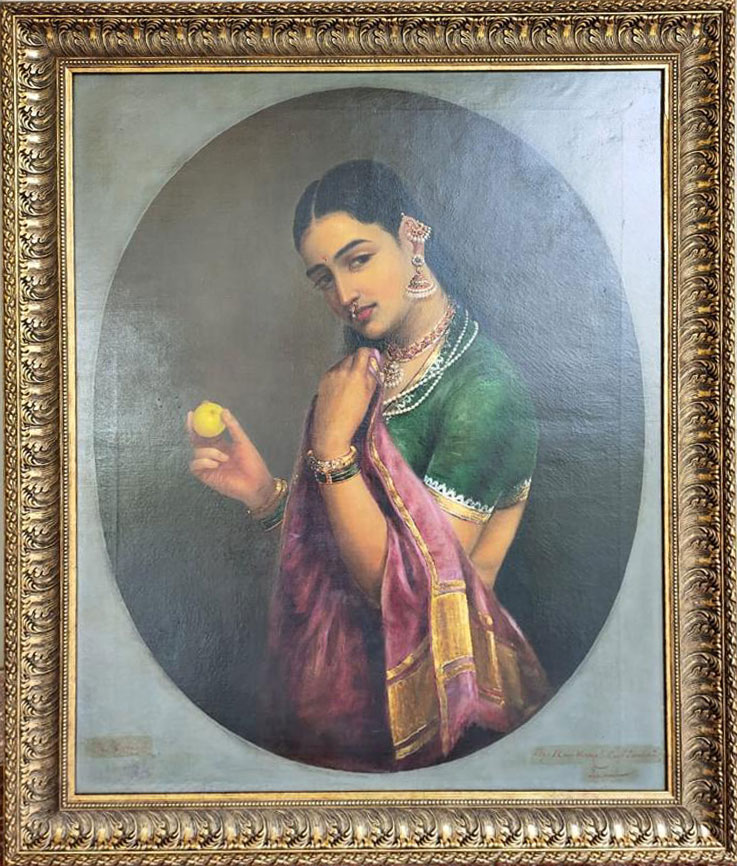
The Coquette
One of the most stunning works created by Ravi Varma, this painting of a lady holding a gooseberry or lemon in her hand was possibly the artist’s way of indicating her pregnant state. Her features, ethereally beautiful like many other women painted by Varma, set a high standard of beauty. The artist has decked her out in an array of jewels and even painstakingly detailed her blouse, clearly showing the fabric to be green velvet.
This painting, which is signed, bears accurate description and style of art works of Raja Ravi Varma in consideration of subject, colour palatte, soft handling of colours and treatment of humanistic emotions and portrayal of the same, and is hereby certified as a ‘Signed Original’.
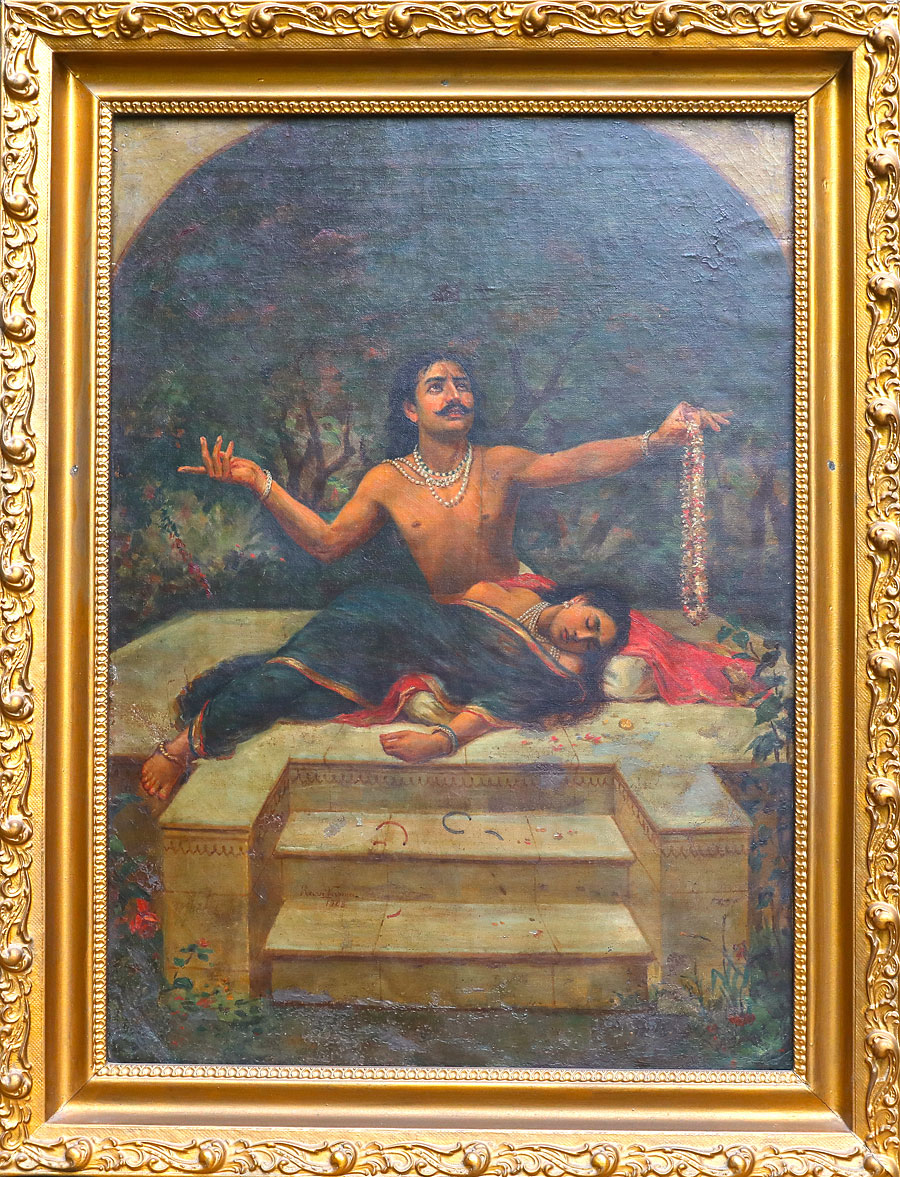
King Aja’s Lament or Fatal Garland
This painting also goes by the another name - The Fatal Garland. Done in 1903, this work done by the master artist draws from mythology and tellingly, Ravi Varma has depicted a tragic scene in a stunning manner.
Aja is on the terrace with his wife and they are having a nice time when Indra passes overhead wearing his garland.
Now, Indra’s garland had a ‘special’ but tragic quality to it that if it fell on anyone that person immediately died. Unfortunately, it fell on Aja’s wife Indumati and she died at the moment of their greatest pleasure.
When the painting was being cleaned, a part of the left side where the varnish was been removed, Aja’s eyes are red and full of unshed tears. So it’s a terrible and tragic moment for Aja that is revealed. If not for this process of restoration, and owing to the varnish, such a tragic moment would have remained invisible.
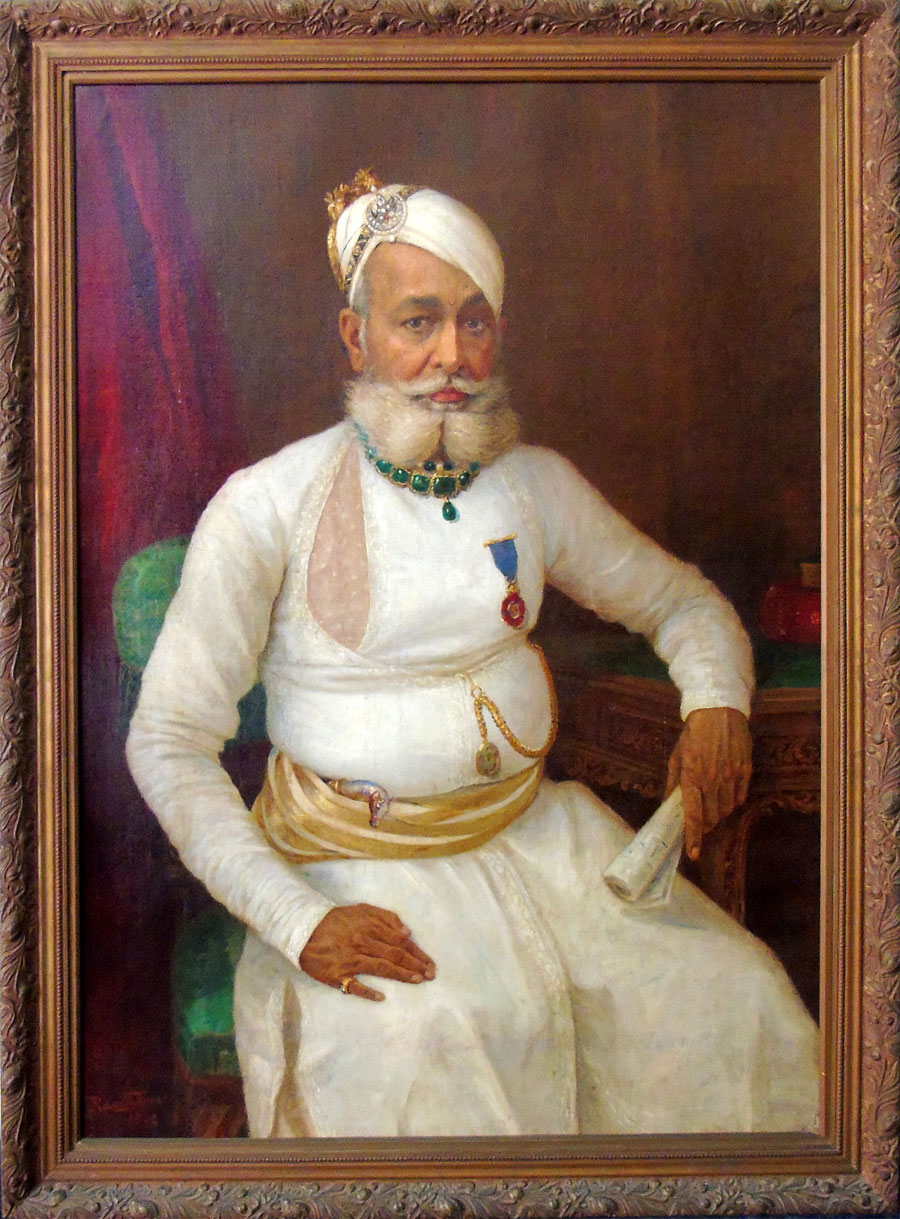
Rai Pannalal Mehta
This painting has been created in 1902 by Raja Ravi Varma. The family sources based on oral tradition have clearly ascribed the work to Raja Ravi Varma. The work and the subject’s association with the artist has also been extensively documented in “Raja Ravi Varma: Portrait of An Artist, The Diary of C. Raja Raja Varma” by Erwin Neumayer and Christine Schelberger and “Raja Ravi Varma: Painter of Colonial India” by Rupika Chawla. There are also several other historical records that clearly establish the dealings Rai Pannalal Mehta maintained with Raja Ravi Varma and his brother C. Raja Raja Varma.
The completed portrait was delivered to Rai Pannalal Mehta and has remained with the Mehta family ever since.
This painting, which is signed, bears accurate description and style of art works of Raja Ravi Varma in consideration of subject, colour pallet, soft handling of colours and treatment of humanistic emotions and portrayal of the same, and is hereby certified as a ‘Signed Original’.
Raja Ravi Varma Heritage Foundation has examined this work and had it registered with the ASI for the present owner.
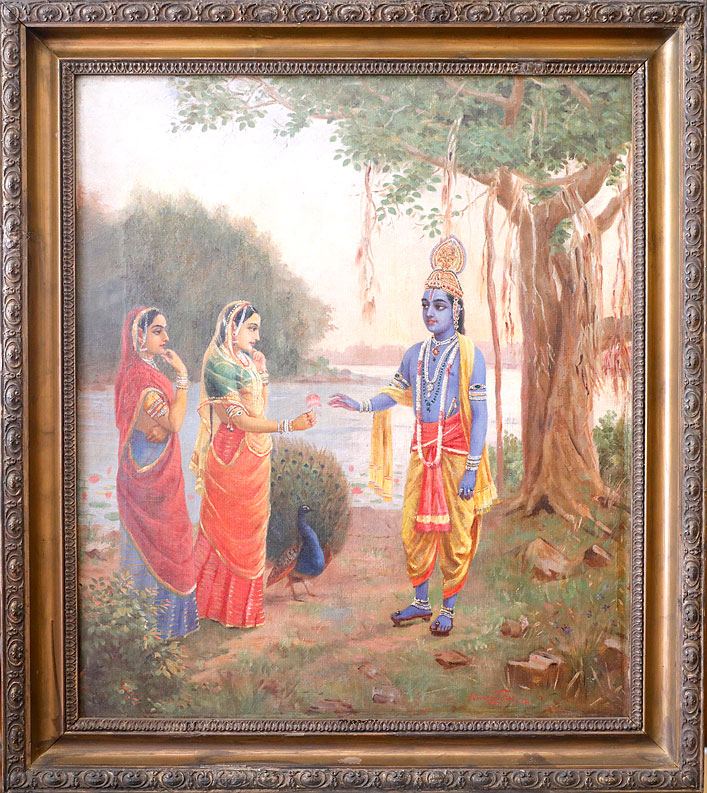
Radha Krishna
Raja Ravi Varma spent several months in Udaipur in 1901 at the invitation of the Maharana. While he was there he spent a lot of his time examining miniature paintings and studying their intricacies and details.
It is a documented fact that Ravi Varma was asked to reproduce paintings of the Maharana’s ancestors from similar paintings of them done in the miniature style. He created large size works of Maharana Pratap Singh, Maharana Jai Singh and Maharana Amar Singh. While Ravi Varma did not care much for the miniature works, he went on to carefully examine works done by other artists who followed that style. Thus many works painted by the artist during that period have been influenced by what he saw and studied of miniature paintings.
This painting of Radha Krishna was made during the artist’s time in Udaipur (it is dated 1901) and hence has reflects many influences of miniature paintings. Radha’s garments, the jewellery on the three figures, the foliage, are all reflective of miniature painting styles.
This painting, which is signed, bears accurate description and style of art works of Raja Ravi Varma in consideration of subject, colour palatte, soft handling of colours and treatment of humanistic emotions and portrayal of the same, and is hereby certified as a ‘Signed Original’.
The Foundation’s assistance was sought to have this artwork registered during distribution of assets of this family.
Documented / Researched / Registered Works by
Raja Ravi Varma's Contemporaries
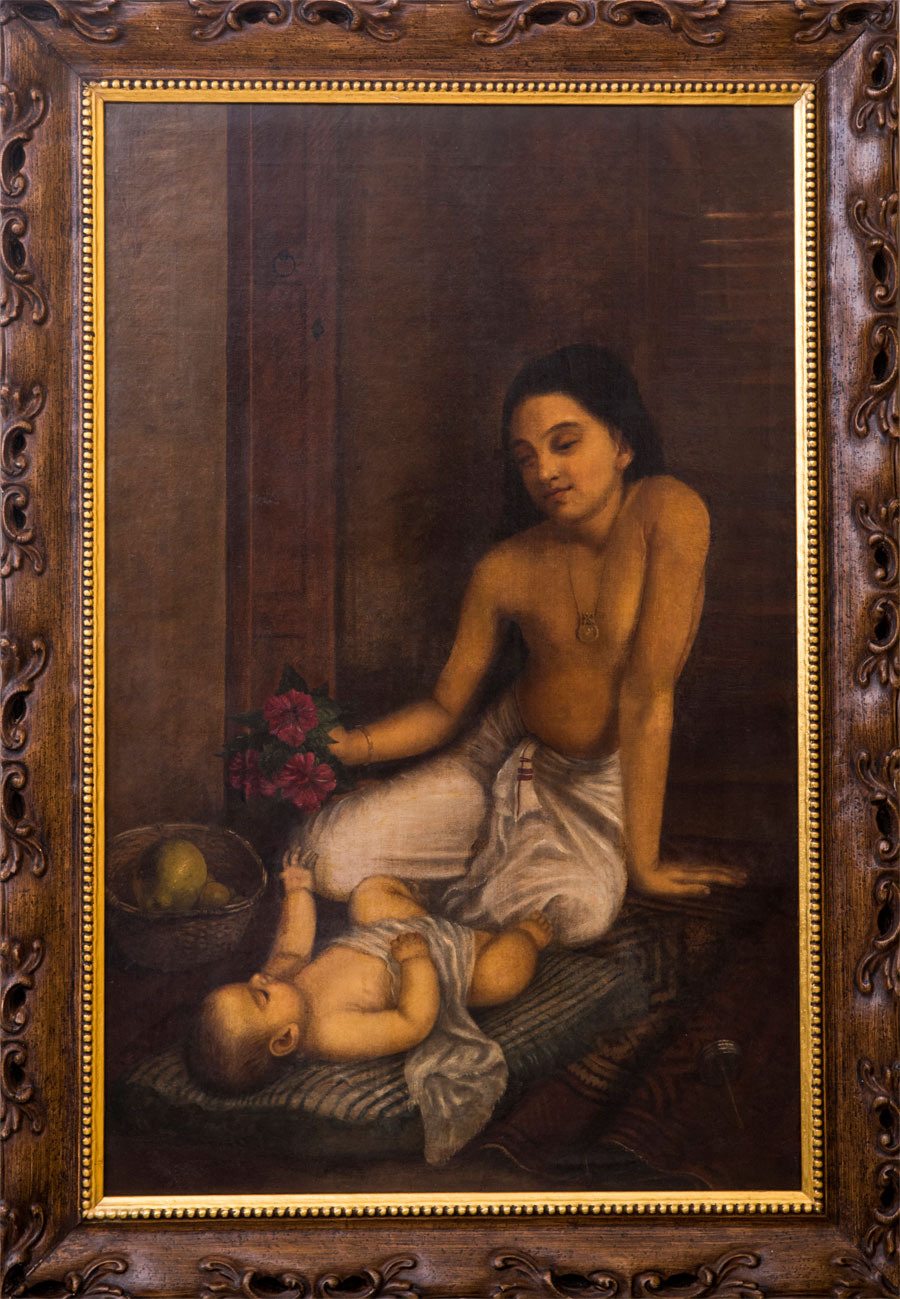
Baby & Princess
Initially presumed to be the work of Raja Ravi Varma given the accurate description and style of art works of the master artist in consideration of colour palettes, soft handling of colours and treatment of humanistic emotions and portrayal of the same, it was subjected to a further and thorough examination.
It was then determined that this painting, though signed by C. Raja Raja Varma (Ravi Varma’s younger brother), based on oral history and the date of the work, definitely reflects the hand of Ravi Varma also. We believe that the painting has been done by the Varma brothers jointly.
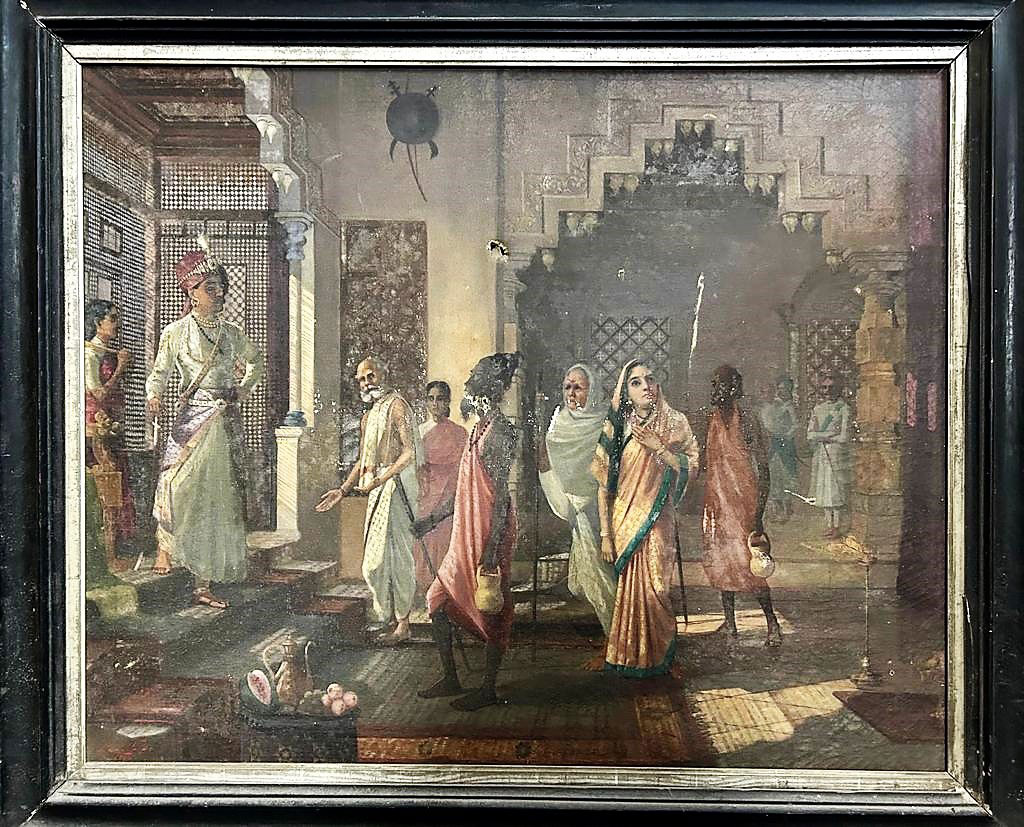
Shakuntala In The Court of Dushyanta - Version 2
Signed ‘Rama Varma’ and dated 1924, this painting of Shakuntala In the Court of Dushyanta appears to be part of a series of work that the artist created on this subject. Like his father Rama Varma was deeply inspired by Kalidasa’s ‘Abhijanashakuntalam’ and painted several scenes from this text. This painting shows the faces of King Dushyanta, Sage Kanva, a perplexed Shakuntala and other characters and courtiers. This tableau like scene is brought to life through Rama Varma’s eye for detail and careful portrayal of each artist with perfect details and expressions.
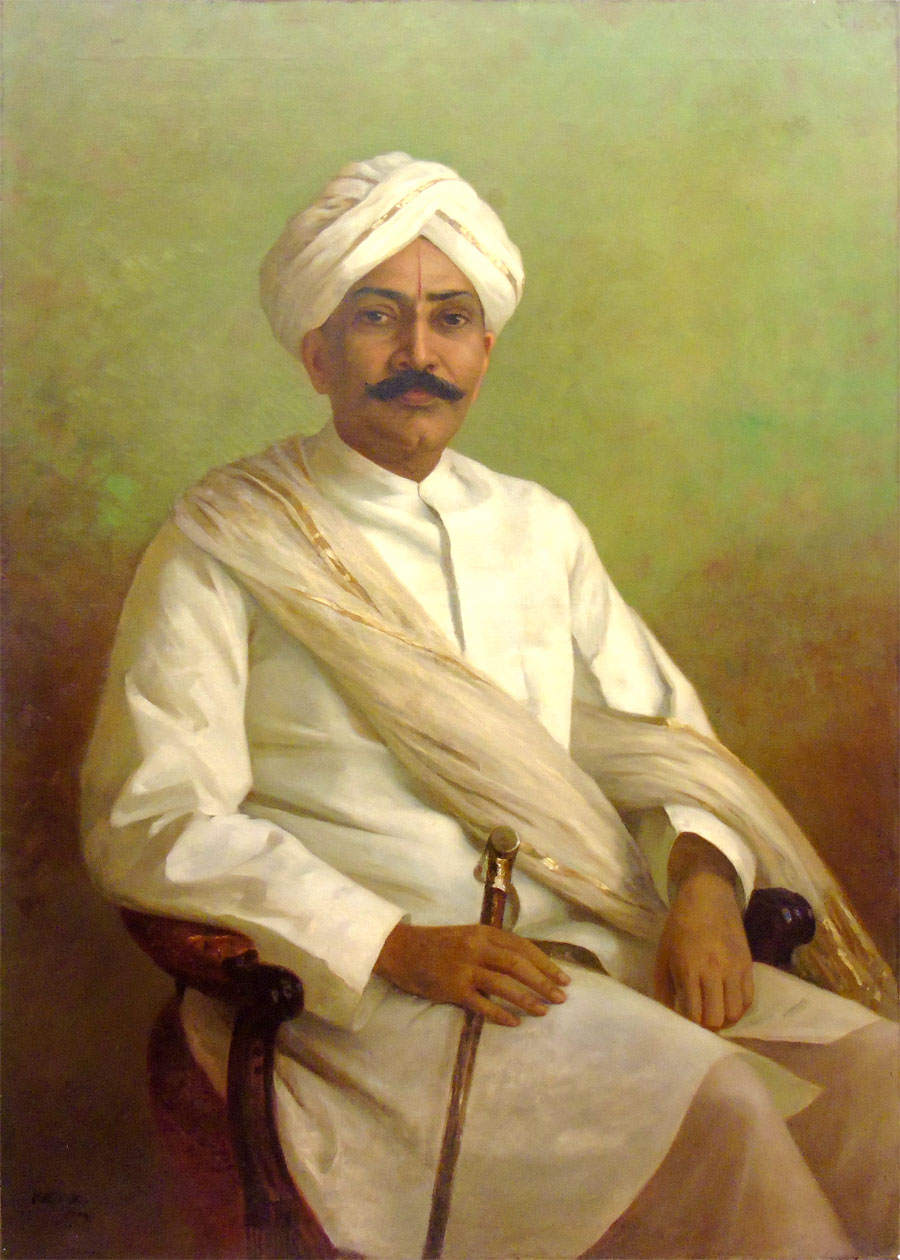
Bandi Balaiah Naidu
Diwan Bandi Balaiah Naidu was a huge supporter of Raja Ravi Varma and his brother C Raja Raja Varma. The artist brothers stayed with the Diwan on several occasions at his palatial home in Pon-namalay in Madras (as mentioned on Page 114 in ‘The Diary of C. Raja Raja Verma’ by Erwin Neumayer and Christine Schelberger).
This portrait of Bandi Balaiah Naidu was possibly done by C Raja Raja Varma as a token of gratitude and a mark of his friendship with the Diwan.
It is hence the opinion of Raja Ravi Varma Heritage Foundation that this work is a ‘Signed Original’ done by the hand of C. Raja Raja Varma.
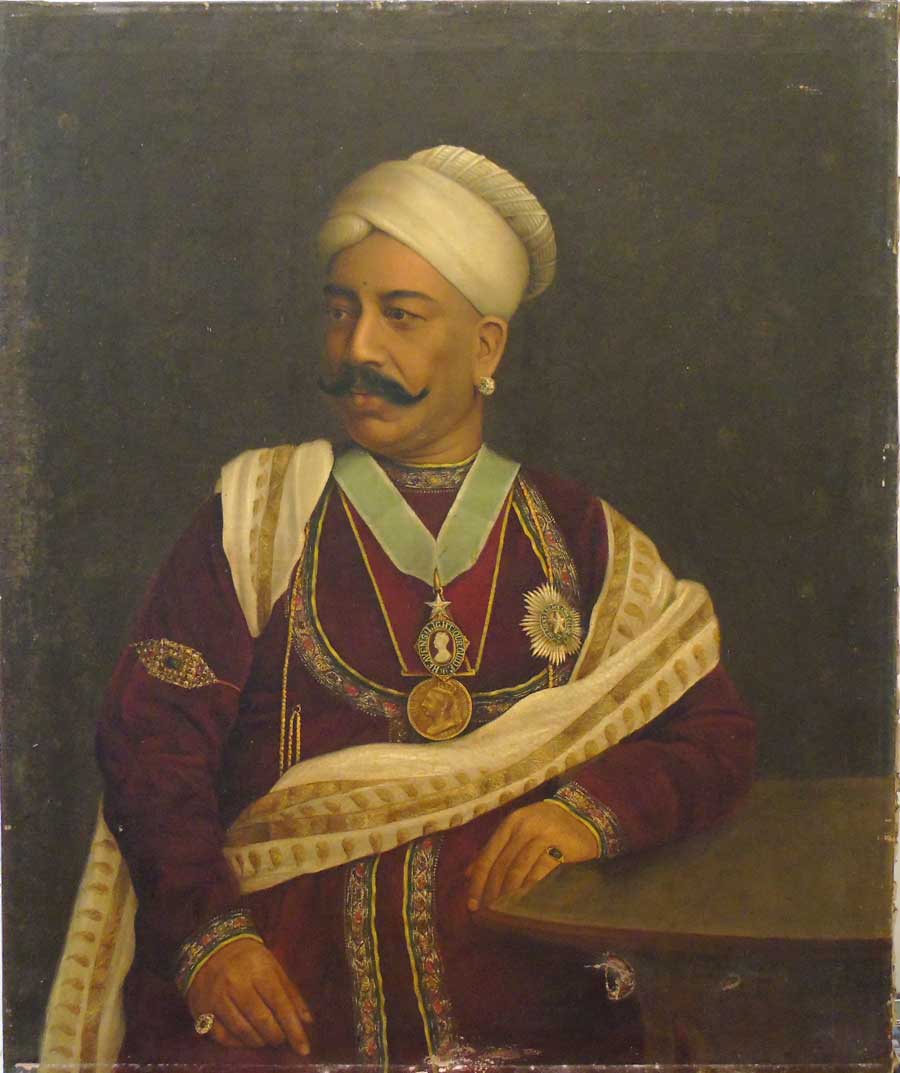
Diwan Sir Thanjavur Madhava Row
The Foundation had provided an opinion regarding this painting based on x-ray visual and physical examination only, and also based on oral traditions, family lineage & inheritance of the present owners (the family are direct descendants of Diwan Sir Thanjavur Madhava Rao, the subject in the portrait).
Based on these examinations the work was initially presumed and attributed to Raja Ravi Varma. However, on cleaning and removing of the hard varnish, a partial inscription of a name was found which was initially hidden under a layer of varnish and was not visible at first by UV, X-Ray or Visual Examination. On this discovery, the painting was immediately sent to Rupika Chawla in New Delhi for further examination. After deep cleaning and further scrutiny on second and third levels we found that there were four areas in this painting that caused us to relook at our initial opinion of the work being attributed to Raja Ravi Varma.
The Foundation has ascertained that this painting has been done by Ravi Varma’s contemporary, an artist called ‘MCT Naidu’. The same has been conveyed to its owner.
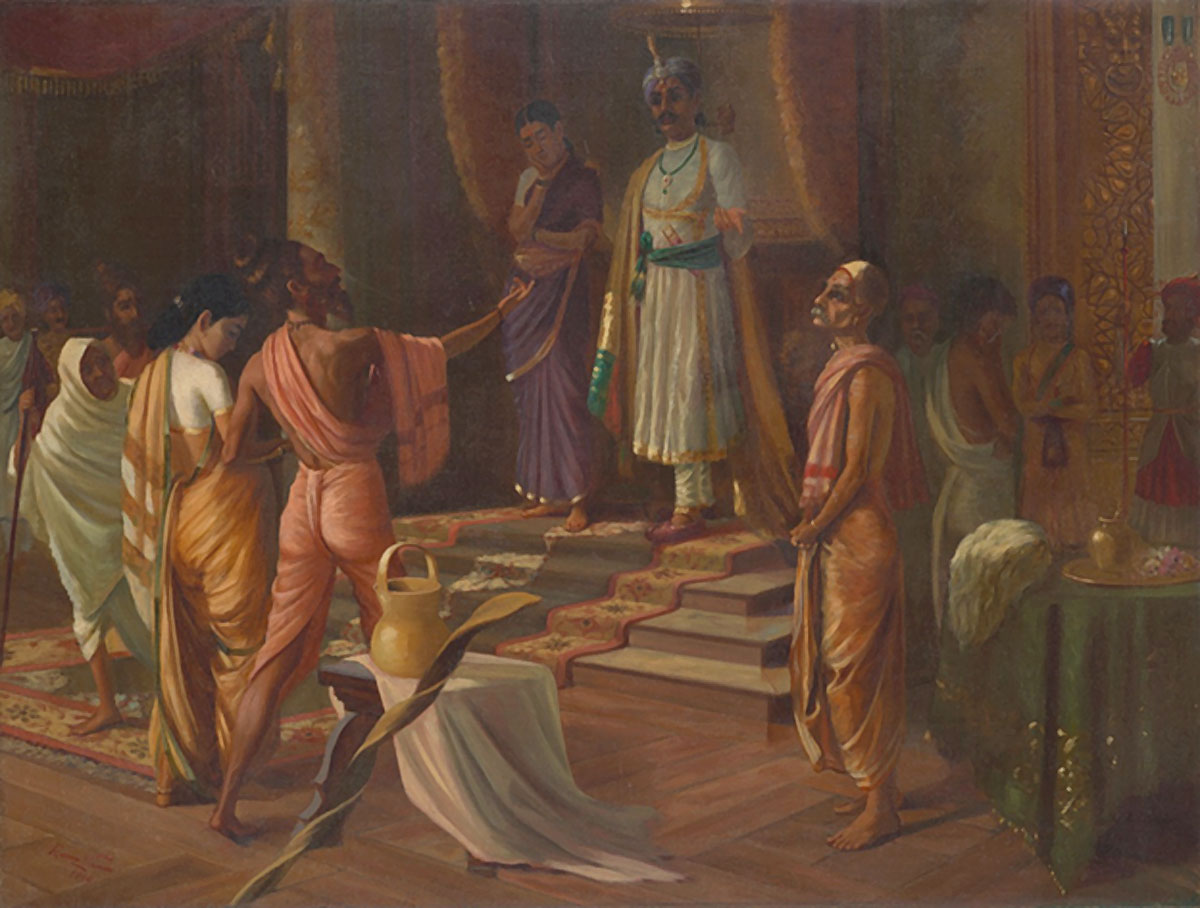
‘Untitled’ ‘Shakuntala in the Court of Dushyanta’
Rama Varma studied at JJ School of Art Mumbai and acquired admirable painting skills. He often assisted his father Ravi Varma and his uncle C Raja Raja Varma in their studio. After Ravi Varma’s death Rama Varma continued to paint for several royal families and his works are part of many royal and museum collections.
The Foundation reviewed this ‘Untitled’ painting by Rama Varma depicting the scene of ‘Shakuntala in the Court of Dushyanta’. Painted in the tableau style that Rama Varma was famous for, this work is assumed to have been created circa 1914 by the artist and bears his clear signature.
